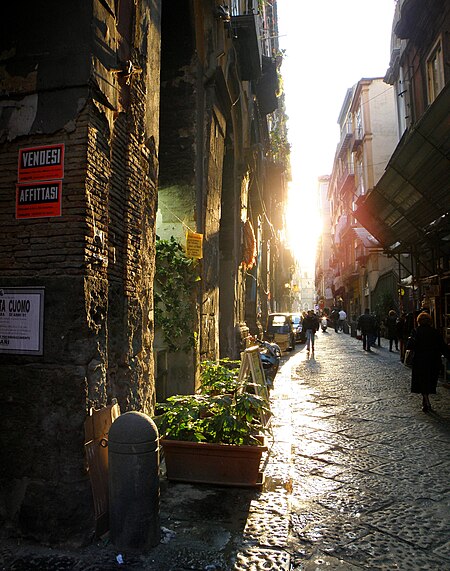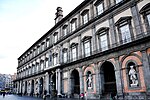Via dei Tribunali, Naples

Via dei Tribunali is a street in the old historic center of Naples, Italy. It was the main decumanus or Decumanus Maggiore — that is, the main east-west street—of the ancient Greek and then Roman city of Neapolis, paralleled to the south by the lower decumanus (Decumano Inferiore, now called Spaccanapoli) and to the north by the upper decumanus (Decumano Superiore) (now via Anticaglia and Via della Sapienza). The three decumani were (and still are) intersected by numerous north-south cross-streets called cardini, together forming the grid of the ancient city. The modern streets/alleys that overlie and follow the ancient grid of these ancient streets. The length of the modern Via dei Tribunali was determined by the urban expansion requirements of the Spanish starting in the early 16th century. The street runs from the church of San Pietro a Maiella and adjacent Naples Music Conservatory at the west end of the old city for about three-quarters of a mile, passing the central cross-road at via San Gregorio Armeno, then crossing via Duomo near the Cathedral of Naples and ending at what was, until quite recently, the main Naples courthouse (Italian: Tribunale), from which the street draws its name.
Excerpt from the Wikipedia article Via dei Tribunali, Naples (License: CC BY-SA 3.0, Authors, Images).Via dei Tribunali, Naples
Percorso Ciclabile Napoli, Naples San Ferdinando
Geographical coordinates (GPS) Address Nearby Places Show on map
Geographical coordinates (GPS)
| Latitude | Longitude |
|---|---|
| N 40.833333333333 ° | E 14.25 ° |
Address
Santa Lucia - Plebistico
Percorso Ciclabile Napoli
80132 Naples, San Ferdinando
Campania, Italy
Open on Google Maps









